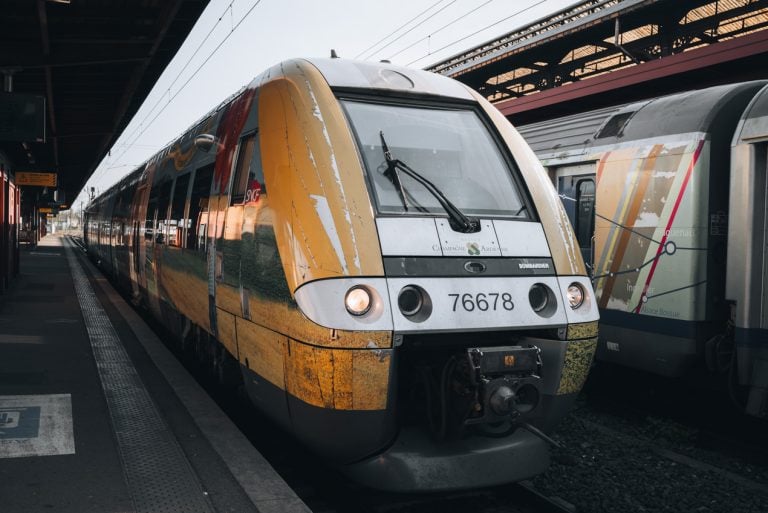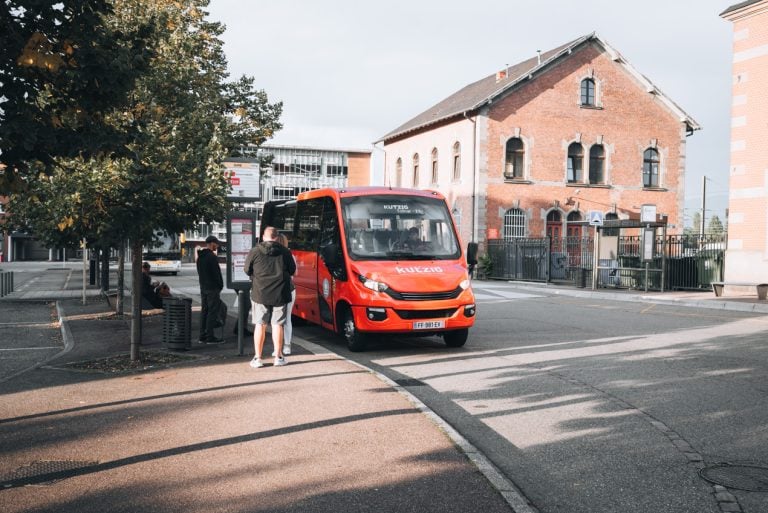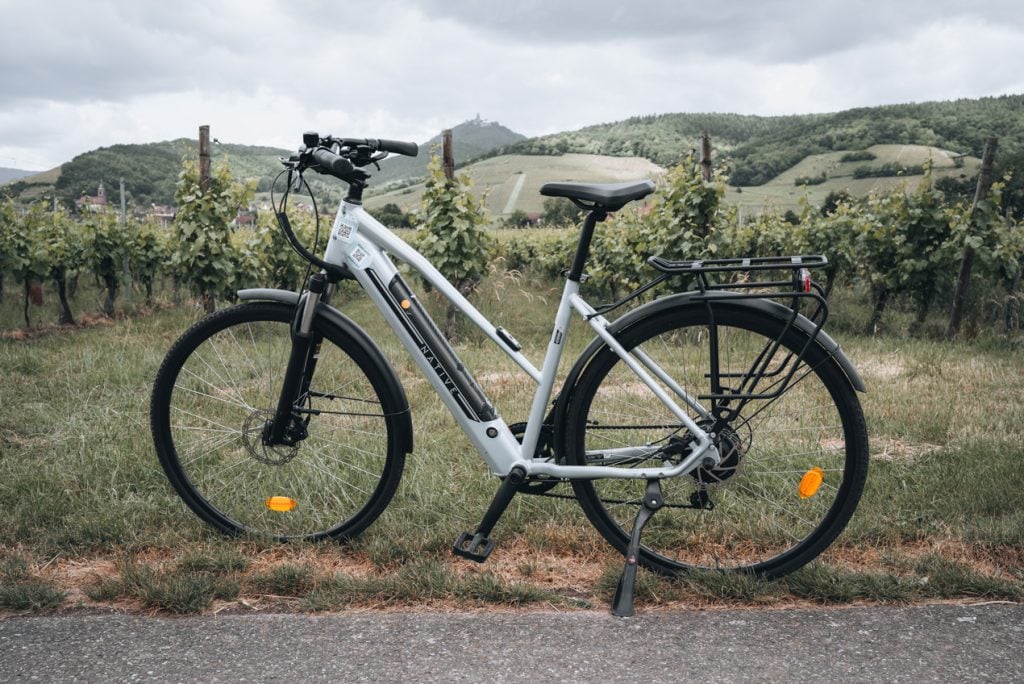Alsace is a beautiful region in eastern France. It’s known for its picturesque villages, rolling vineyards, and savory dishes.
However, getting around can be challenging, especially for first-time visitors.
I moved to the capital of Alsace in 2019 and have been exploring the region ever since. I travel mostly by public transport, but I have rented a car a few times, so I know how to get around.
In this guide, I’ll share with you how to get around Alsace as well as some tips for using public transportation and renting a car.

Please note: This post contains affiliate links, meaning I may earn a commission if you make a purchase by clicking on a link (at no extra cost to you). Privacy Policy.
Types of Transport
By Train

The train network in France is one of the best ways to travel without a car.
The regional train system in Alsace is run by Transport Express Régional, a branch of SNCF. You will often see it abbreviated as TER.
It’s efficient, reliable, and covers most towns and cities within the region.
The main train stations in Alsace are Strasbourg, Colmar, and Mulhouse. These three cities also have connections to major cities outside of Alsace, such as Paris, Basel, and Frankfurt.
Helpful Tip: Popular towns like Eguisheim, Riquewihr, Ribeauvillé, and Kaysersberg DO NOT have a train station.
Tickets can be purchased on the SNCF-Connect website or app. And, unlike TGV trains in France, you can buy your tickets the same day you plan to travel. Prices are typically fixed, and there are no assigned seats.
Below is a list of popular connections and their travel times:
- Strasbourg to Colmar (30 minutes)
- Strasbourg to Mulhouse (55 minutes)
- Strasbourg to Basel (80 minutes)
- Strasbourg to Paris (105 minutes)
- Strasbourg to Sélestat (20 minutes)
- Colmar to Mulhouse (30 minutes)
- Colmar to Paris (140 minutes)
- Colmar to Basel (45 minutes)
Helpful Tip: Check out my complete guide on how to travel from Strasbourg to Colmar.
By Bus

Alsace has several bus networks that go to villages without a train station. Some are more efficient than others, and I will cover each below.
- Public Bus: This is the standard public bus. It’s not the most reliable form of transport. Itineraries can be found on the Fluo Grand Est app, and tickets must be purchased on the bus with cash (€4 one-way).
- Kutzig Bus: This is a hop-on-hop-off bus that starts and ends in Colmar. It stops by Eguisheim, Turckheim, Kaysersberg, Riquewihr, Hunawihr, and Ribeauvillé. I’ve used it several times and love it. The only downside is that it doesn’t operate year-round.
- Navettes de Noël: This is the Christmas market shuttle bus. It starts and ends in Colmar and goes to Eguisheim, Turckheim, Munster, Riquewihr, Kaysersberg, Ribeauvillé, and Neuf-Brisach. Tickets go on sale in mid-November and sell out quickly.
- Navette des Crêtes: This is a seasonal bus that goes to the Grand Ballon, the Lac Blanc, and other destinations in the Vosges Mountains. There are several starting points, including Colmar. Tickets can be purchased online or on the bus and are €4 one-way.
- Château du Haut-Koenigsbourg Shuttle: This is a shuttle bus that goes from Sélestat to Château du Haut-Koenigsbourg. Tickets are €2.50 one-way and can be purchased on board. Debit/credit cards are not accepted.
- Flixbus: This is a long-distance bus that travels between cities like Strasbourg and Colmar and Strasbourg and Paris. Tickets are sometimes cheaper than the train, but the travel times are much longer.
By Bike

Biking is a great way to explore the region without a car.
Aside from Strasbourg, most towns in Alsace are small enough that they can be explored on foot.
But there are several long-distance biking routes that you can use to explore the countryside and even travel between towns.
The two most popular routes are the Alsace Wine Route and the Rhine Cycle Route (EuroVélo 15).
The Alsace Wine Route is 170 kilometers (105 miles) that weaves from Marlenheim to Thann, passing a total of 120 villages. Most of the route follows a bike path dedicated to cyclists, but certain sections are shared with cars.
The Rhine Cycle Route (EuroVélo 15) is one of the longest bike paths in Europe. It runs from the Swiss Alps to the North Sea, passing through Alsace.
The section in Alsace is mostly flat and dedicated to cyclists. It’s also easier than the Alsace Wine Route. The most popular sections run from Strasbourg to Colmar.
You can rent bikes from various shops around the region, but Strasbourg and Colmar have the most options.
If you want to rent a bike in Strasbourg, there are a few options:
If you want to rent a bike in Colmar, I recommend Détour Alsace. They are reliable and their bikes are top-notch. (They also have several bike tours that are fantastic for exploring the area around Colmar.)
Helpful Tip: Détour Alsace is based in Sélestat, but they deliver bikes to Colmar.
By Car

Renting a car is another popular option for exploring Alsace. It gives you more flexibility and allows you to visit smaller villages that are not easily accessible by public transport.
Strasbourg is the best and easiest place to rent a car. Options like Discover Cars and Rental Cars will offer you the best price, or you can rent from companies like Sixt, Hertz, Europcar, and Enterprise.
All of them are located at Strasbourg’s central train station, so rental cars are easy to pick up and drop off, even during holidays.
I’ve used both Discover Cars and Sixt in Strasbourg, and both were ok.
Helpful Tip: If you plan on driving in Strasbourg your vehicle will need a Crit’Air sticker. Most rental companies in Alsace provide it, but that’s not always true for cars rented outside the region.
Colmar is another option, but they have fewer companies, with most of them located outside the city. Only Hertz and Avis are downtown, and they don’t have a lot of cars.
Aside from cities, you can also rent cars at the nearby airports. Both Strasbourg Airport and EuroAirport (Basel-Mulhouse-Freiburg) have several car rental options. The rental costs are usually higher than renting a car in Strasbourg.
Finally, once you’ve decided to rent a car, you will need to park it. Most towns have a parking lot that is within walking distance of the town’s center. You can pay with a debit card or use an app (Easypark, Paybyphone, and Flowbird).
Helpful Tip: All three apps also indicate where to find parking lots for each town and the number of available spaces.
Convenient Travel Hubs
There are three major travel hubs in Alsace: Strasbourg, Colmar, and Mulhouse.
Strasbourg is the largest city and has an international airport, making it a popular entry point. It also has a major train station with connections to many other European cities.
Colmar is a smaller city than Strasbourg with a train station that connects to other towns in the region as well as Paris. It’s also where public buses, the Kutzig bus, and the Navettes de Noël start.
Mulhouse is the second-largest city in Alsace. It’s also near an international airport (EuroAirport (Basel-Mulhouse-Freiburg)) and a train station with connections to other cities in France.
Helpful Tip: Colmar and Strasbourg are both better bases for exploring the region than Mulhouse, but Mulhouse is a great transfer hub.
Conclusion
There are several ways to get around this part of France, and over the years I’ve used every one of them.
I recommend deciding which towns you want to visit before choosing a mode of transport.
If you don’t want to use public/tourist buses and visit towns without a train station, renting a car is the best option.
Finally, for planning a trip, I recommend these apps and websites.
Read More Articles
I hope you enjoyed my post and found it helpful. Here are some other articles that I think you might find interesting.
- 25 Amazing Things to Do in Alsace (Local’s Guide)
- Best Time to Visit Alsace, France (A Local’s Guide)
- 6 Best Ways to Get from Colmar to Eguisheim